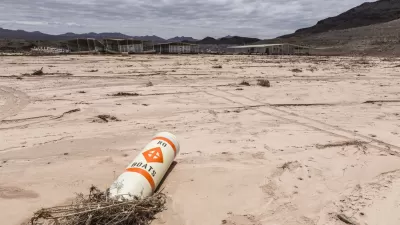The Seattle region would seem to have plenty of water to go around. That doesn't mean there aren't environmental consequences for more development.

"[E]ven in rainy, water-abundant Seattle, the region’s astronomical growth has given rise to new conflicts over water rights for people and salmon," according to an article and on-air report by Joshua McNichols.
The case study for the pressure between sprawl and water supply is set along the Snoqualmie River, found about 30 miles outside of Seattle and in the opening credits of the television show Twin Peaks. The city of Snoqualmie has been growing quickly, but upstream the city of North Bend, where Twin Peaks was mostly filmed, is stuck in the past due to a 1999 housing construction moratorium, implemented when the city got caught drawing more water than permitted from wells.
Now, developers have proposed a 212-unit development in North Bend, but "local environmental activists are demanding to know whether that building would put new strain on an already-overburdened waterway."
According to North Bend Mayor Ken Hearing, the development will bring workers, many of whom now commute from much farther south in King County, closer to North Bend's "struggling" commercial core. Mayor Hearing is also motivated to generate revenue from development that North Bend lacks, but other cities nearby have managed to collect on for years.
Jean Buckner represents the Friends of the Snoqualmie Trail and River, the environmental group opposing the apartment development. According to McNichols, "Buckner said she’s not against growth in North Bend. She just wants to see the city demonstrate that the river can withstand this new development."
FULL STORY: Water fuels Seattle’s growth. But in North Bend, activists say water could be running out

Study: Maui’s Plan to Convert Vacation Rentals to Long-Term Housing Could Cause Nearly $1 Billion Economic Loss
The plan would reduce visitor accommodation by 25,% resulting in 1,900 jobs lost.

North Texas Transit Leaders Tout Benefits of TOD for Growing Region
At a summit focused on transit-oriented development, policymakers discussed how North Texas’ expanded light rail system can serve as a tool for economic growth.

Using Old Oil and Gas Wells for Green Energy Storage
Penn State researchers have found that repurposing abandoned oil and gas wells for geothermal-assisted compressed-air energy storage can boost efficiency, reduce environmental risks, and support clean energy and job transitions.

Santa Barbara Could Build Housing on County Land
County supervisors moved forward a proposal to build workforce housing on two county-owned parcels.

San Mateo Formally Opposes Freeway Project
The city council will send a letter to Caltrans urging the agency to reconsider a plan to expand the 101 through the city of San Mateo.

A Bronx Community Fights to Have its Voice Heard
After organizing and giving input for decades, the community around the Kingsbridge Armory might actually see it redeveloped — and they want to continue to have a say in how it goes.
Urban Design for Planners 1: Software Tools
This six-course series explores essential urban design concepts using open source software and equips planners with the tools they need to participate fully in the urban design process.
Planning for Universal Design
Learn the tools for implementing Universal Design in planning regulations.
Ascent Environmental
Borough of Carlisle
Caltrans
Institute for Housing and Urban Development Studies (IHS)
City of Grandview
Harvard GSD Executive Education
Toledo-Lucas County Plan Commissions
Salt Lake City
NYU Wagner Graduate School of Public Service





























